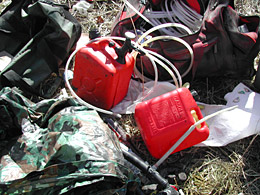 |
 |
 |
 Health & Beauty | August 2005 Health & Beauty | August 2005  
War On Drugs Pushing Meth Labs South Of The Border
 Sergio Chapa - The Brownsville Herald Sergio Chapa - The Brownsville Herald


| | Recent seizures are reportedly among the largest attempts to control meth production in Mexico by disrupting the flow of its ingredients. |
Mexico City - The shutdown of thousands of methamphetamines labs in the United States along with stricter laws regulating household items that can be used to make the narcotic have pushed production south of the border.

The synthetic drug, which produces a strong euphoria and addiction among its users, has exploded in the last five years as its use popularity moves from California, Texas and the Midwest to the East Coast.

U.S. Drug Enforcement Agency (DEA) figures show that American law enforcement officials have shut down or identified more than 73,000 labs and chemical dump sites in the United States since 2000.

At the same time, more than 20 states have passed laws that regulate the sale of over-the-counter medication that contains pseudoephedrine, the main chemical used to make methamphetamines or “meth.”

Texas joined those states on Aug. 1 requiring pharmacists and retailers to keep products containing the chemical secure in addition to keeping logs of each purchase.

Despite frequent seizures and stronger legislation, DEA reports show that consumption of methamphetamines has not subsided, pushing an ever-growing percentage of production into Mexico where it can be made cheaply and smuggled easily into the United States.

“Methamphetamines production has moved south,” said Ray D’Alessio with the DEA’s Houston Regional Office. “Mexican drug traffickers already have established transportation routes and markets for cocaine and marijuana.”

DEA reports show that as much as 80 percent of all methamphetamines used in the United States is made in Mexico.

Intelligence reports show that Mexican manufacturers buy pseudoephedrine tablets in large shipments from China, Panama, India and other nations to make inexpensive and highly pure forms of methamphetamines.

D’Alessio said the key areas of meth production in Mexico are the states of Baja California, Jalisco, Michoacan, Morelos and Guerrero where “super labs” can produce more than 10 pounds of the drug in one 24-hour cycle almost undisturbed.

Once packaged, methamphetamines is most commonly placed in hidden compartments of passenger vehicles and then smuggled into the United States through international bridges or other land-based ports of entry.

DEA figures show that methamphetamine seizures along the U.S./Mexico border dramatically increased from 14 pounds in 1992 to 3,820 pounds in 2003.

Although California and Arizona remain the top entry points, DEA reports show that a growing appetite for methamphetamines along the East Coast has brought increased amounts of the drug through Texas.

In 2003, customs agents seized a record 1,067 pounds of meth at the Lone Star State’s 24 international bridges.

DEA intelligence reports show that Mexican authorities are poorly trained to detect or limit the production of methamphetamines or prevent it from entering the United States.

Of the 10 meth labs seized by Mexican authorities in 2002, a DEA report shows that almost all of the seizures were made as a result of explosions from dangerous chemical reactions or persistent complaints of foul odors.

U.S. Ambassador to Mexico Tony Garza said American federal agents are working with their Mexican counterparts to stem the flow of methamphetamines and other illegal drugs before they enter the United States.

“The environment for cooperation here in Mexico is much better than it has ever been,” Garza told The Brownsville Herald. “The Fox administration is very committed as was (President) Cedillo to opening the lines of communication.”

D’Alessio said part of that communication includes intelligence sharing, conducting joint investigations and training Mexican prosecutors and law enforcement officials about the production and distribution of meth.

DEA figures show the cooperation between American and Mexican officials has produced some results in the war against methamphetamines.

According to the U.S. State Department’s 2005 International Narcotics Control Strategy Report, Mexican authorities seized 1,300 pounds of methamphetamines in 2004 compared to 211 pounds in 1998.

Figures obtained from the DEA’s office in Mexico City show that authorities from both sides of the border have monitored the movements of more than 567 million pseudoephedrine tablets in Mexico since January.

Depending on the method of extraction, the tablets could have potentially been used to produce 52,000 pounds of methamphetamines with an estimated street value of $307.9 million.

DEA figures show that Mexican authorities seized more than 97 million of those tablets after learning they were destined to produce methamphetamines.

The seizures are reportedly among the largest attempts to control meth production in Mexico by disrupting the flow of its ingredients. | 
 | |
 |



